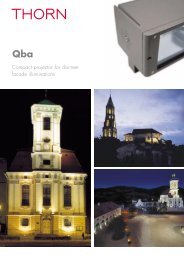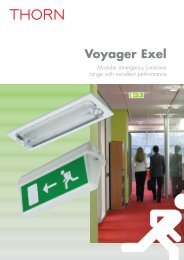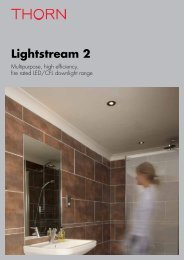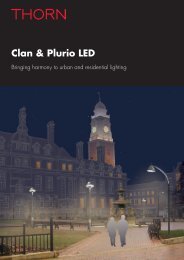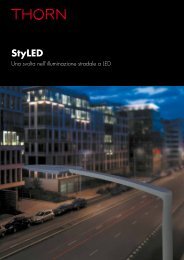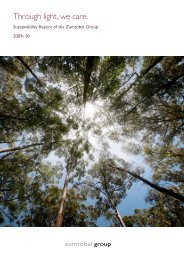Download the Thorn Lighting and Sustainability brochure
Download the Thorn Lighting and Sustainability brochure
Download the Thorn Lighting and Sustainability brochure
You also want an ePaper? Increase the reach of your titles
YUMPU automatically turns print PDFs into web optimized ePapers that Google loves.
<strong>Lighting</strong> energy numeric<br />
indicator (LENI)<br />
Daylight operating hours (t D<br />
) – installation operating hours when daylight is present. Units: hours.<br />
Non-daylight operating hours (t N<br />
) – installation operating hours where daylight is not present. Units: hours.<br />
Annual operating time (t O<br />
) – <strong>the</strong> annual number of hours with <strong>the</strong> lamps operating (i.e. turned on)<br />
where t D<br />
<strong>and</strong> t N<br />
are defined above.<br />
t O<br />
= t D<br />
+ t N<br />
St<strong>and</strong>ard year time (t y<br />
) – <strong>the</strong> time taken for one st<strong>and</strong>ard year to pass, taken as 8760 hours.<br />
Emergency lighting charge time (t e<br />
) – <strong>the</strong> operating hours during which <strong>the</strong> emergency lighting batteries are<br />
being charged. Units: hours.<br />
Constant illuminance factor (F C<br />
) – this is a factor relating to <strong>the</strong> usage of <strong>the</strong> total installed power when<br />
constant illuminance control is in operation in <strong>the</strong> area . When constant illuminance control is not in<br />
operation this has <strong>the</strong> value of 1. Units: none.<br />
F C<br />
= (1+MF) / 2 where MF is <strong>the</strong> maintenance factor for <strong>the</strong> scheme.<br />
Occupancy dependency factor (F O<br />
) – this is a factor relating <strong>the</strong> usage of <strong>the</strong> total installed lighting power<br />
when occupancy control is in operation in <strong>the</strong> area. When occupancy control is not in operation this has <strong>the</strong><br />
value of 1. Units: none<br />
Daylight dependency factor (F D<br />
) – this is a factor relating <strong>the</strong> usage of <strong>the</strong> total installed lighting power to<br />
daylight availability in <strong>the</strong> area. When daylight control is not in operation this has <strong>the</strong> value of 1.<br />
Units: none<br />
The LENI formula is<br />
LENI = W A<br />
where<br />
W is <strong>the</strong> total energy used for lighting a room or zone in kWh/year<br />
<strong>and</strong><br />
A is <strong>the</strong> total useful floor area of <strong>the</strong> building in m 2 .<br />
W is composed of two components<br />
where<br />
W L<br />
is <strong>the</strong> annual lighting energy required to provide illumination so that <strong>the</strong> building may be used.<br />
W P<br />
is <strong>the</strong> annual parasitic energy required to provide charging energy for emergency lighting systems <strong>and</strong><br />
st<strong>and</strong>by energy for lighting control systems.<br />
W L<br />
may be calculated using <strong>the</strong> formula<br />
where <strong>the</strong> individual terms are defined above.<br />
W P<br />
may be calculated using <strong>the</strong> formula<br />
where <strong>the</strong> individual terms are defined above.<br />
W = W L<br />
+ W P<br />
[kWh/year]<br />
W L<br />
={(P n<br />
xF C<br />
)x[t D<br />
xF O<br />
xF D<br />
)+(t N<br />
xF O<br />
)]}/1000<br />
W P<br />
={{P PC<br />
x[t y<br />
-(t D<br />
+t N<br />
)]}+(P em<br />
xt e<br />
)}/1000<br />
29


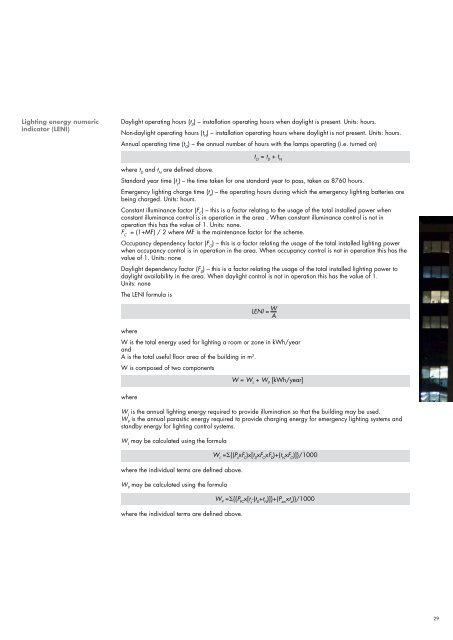
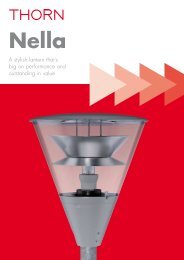
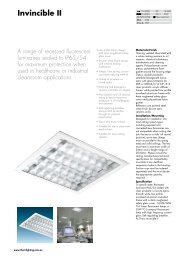
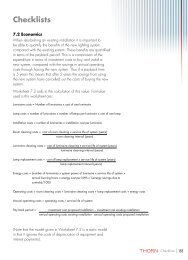
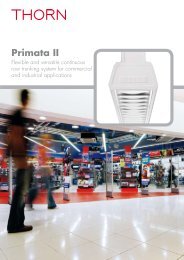
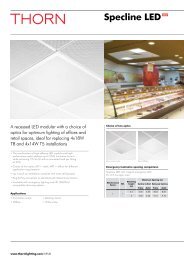

![Produkt brochure [PDF/4MB] - THORN Lighting](https://img.yumpu.com/50705283/1/184x260/produkt-brochure-pdf-4mb-thorn-lighting.jpg?quality=85)
